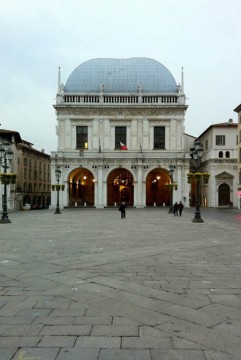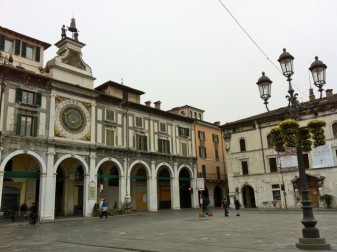 Piazza della Loggia
Piazza della Loggia
Is one of the most beautiful Venetian style squares outside of Venice itself.
Its construction was initiated in 1433 by Marco Foscari, the Venetian mayor of Brescia, when it replaced a maze of lanes in the medieval city; its completion took over a century. Built around the square were the Loggia, the Monte Vecchio and Monte Nuovo di Pietà, and the porticoes surmounted by the Clocktower.
The Loggia was started in 1492 and finished circa 1570, it is a symbol of the city and main office of the City Council. Some of the greatest architects of the time helped in its design including Sansovino and Palladio. Its sculptural decoration in Botticino marble is particularly impressive.
The building’s original lead roofing was lost in a fire in 1575 which also destroyed the three large ceiling paintings by Titian. After a series of temporary solutions, the cupola seen today was built in 1914 inspired by the Renaissance model.
The Monte Vecchio di Pietà
Together with the Monte Nuovo di Pietà, it stands on the south side of the square.
It was built between 1848 and 1498 and features an elegant small lodge.
 The Clocktower
The Clocktower
It stands facing the Loggia in the centre of the colonnade built in 1595. The mechanical astronomic clock is very beautiful and features the signs of the Zodiac and the Sun.
The Polyptych by Titian
In the church of Santi Nazaro e Celso one of Titian’s early masterpieces is kept, the Averoldi Polyptych of 1522. It is given this name because it was commissioned by the Brescian nobleman Altobello Averoldi. It is made up of 5 panels: Christ resurrected in the centre, flanked by the Angel and the Virgin, and below, Santi Nazaro e Celso with donor, and San Sebastiano.
The Tosio Martinengo Art Gallery
Housed in the 16th century Martinengo da Barco building in piazza Moretto, the art gallery holds one of the most important collections of Italian paintings. The works exhibited run from the 13th to the 18th centuries.
The collection centres on paintings by the great Brescian Renaissance masters (Foppa, Ferramola, Romanino, Moretto and Savoldo) beside which are masterpieces by Raphael, Paolo Veneziano, Solario, Francia, Lotto, Gambara and Pitocchetto. The art gallery was established in 1908 following the fusion of the Galleria Tosio with the Galleria Martinengo, and has since been enriched by other bequests and acquisitions.
It now includes many works originally from city churches and private houses too.
OTHER THINGS TO SEE
Church of S. Faustino in riposo – Via dei Musei
A small circular church with a curious conical cupola in brick built at the end of the 12th c. It stands at the end of via dei Musei, next to the tower of the Porta Bruciata. The interior was redecorated during the 18th and 19th c.
Church of San Francesco – Via S. Francesco
This 13th c. church is the most beautiful Romanesque – Gothic church in Brescia. It is rich in interior decoration with 14th and 15th c. frescoes by Moretto and Romanino, a 15th c. wooden choir stall and attractive marquetry. The cloister is also very beautiful.
The Pallata Tower – Via Pace
This is one of the symbols of Brescia: it is 31 m high and dates from the 13th c. The Bagnadore-s fountain was placed at its base in 1596 which allegorically commemorates Brescia and its two rivers, the Garza and the Mella.
Church of Santa Maria del Carmine – Contrada del Carmine
This interesting Romanesque – Gothic church was built in the 15th c. and reworked a century later.
It has an unusual decorated brick façade.
Church of San Giuseppe – Vicolo San Giuseppe
The church is part of a large complex of 16th century conventual buildings. The façade is enriched by three portals and there are three splendid cloisters decorated with frescoes between 1500 and 1700. Housed in the complex is the Diocesan Museum of Sacred Art. Inside there are 20 chapels dedicated to arts and professions.
Cloister of the Monastero Santi Cosma e Damiano – Via dei Mille
The large 15th century cloister has been largely rebuilt but retains its harmony. Names of Brescians killed at war are inscribed on the columns: that’s why it is called “The Memorial”.
Church of S. Maria dei Miracoli – Corso Martiri della Libertà
A jewel of renaissance Lombard art, the church has an elegant marble façade decorated by the same masters that worked on the Loggia. Inside there is a picture of the Madonna, considered to have miraculous powers.
Church of San Giovanni Evangelista – Contrada San Giovanni
Originally early Christian, the church was rebuilt in 1400. Inside it has fine works by painters from the Brescian school. The chapel of the Holy Sacrament is decorated with paintings by Moretto and Romanino.
Church of Santa Maria delle Grazie – Via Grazie
This church has a splendid renaissance doorway which preserves the wooden 1490 doors and a sumptuous interior decorated with frescoes and baroque stuccoes. A cloister connects the church to the Sanctuary, rebuilt in neo-Renaissance style in 1876 by Arch. Antonio Tagliaferri.
Church of San Pietro in Oliveto – Via del Castello
Flanked by two 16th century cloisters, this church has an elegant Renaissance façade and a Romanesque apse. Inside there are paintings by Paolo da Caylina the Younger of Andrea Celesti.
Photo: Andrew Nash
